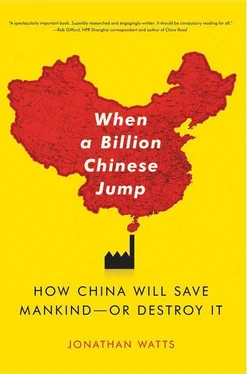The laws of the former kings did not permit the extermination of the whole herd or flock or the trapping of the young. They did not allow the draining of ponds to fish, the burning of woods to hunt, the spreading of nets in the wild prior to the autumn’s wild dog sacrifice, the setting of nets in the water prior to the spring’s otter sacrifice, the stretching of bird nets in valleys and river gorges before the autumn falconry, the logging of hill forests before the autumn shedding of leaves, the burning off of fields before the hibernating of the insects. They did not allow the killing of pregnant animals, the collecting of fledglings and bird eggs, the taking of fish less than a foot in length, or the consumption of piglets less than a year old. Thus grasses and trees billowed forth like rising steam, birds and animals rushed to their domains like a flowing spring, and birds of the air warmed to them like clouds of smoke because they had that which brought all this about. 18
This expression of an ideal balance between man and nature was part of an ultimately unsuccessful polemic in a political battle. The Book of the Prince of Huainan was written at an intellectual turning point in China’s history around 150 BC. The golden age of philosophy, which had produced Confucius, Mencius, Zhuangzi, and Lao-Tzu, had come to an end and the ideas of the greats were literally being fought over. The book, thought to have been compiled by the Taoist naturalist Liu An, 19challenged many of the prevailing beliefs of the age. Liu advocated a rational, activist naturalism, a search for harmonious balance—or what we might today call sustainability. He redefined the central Taoist concept of wuwei from “no inteference” to “no interference contrary to nature.”
But this led him into conflict with schools of Confucianism and Legalism, for whom the organization of human society took precedence. 20Liu An rose up in rebellion against his nephew, the Wu emperor, in 122 BC. When his army was crushed, so was the concept of Taoism he espoused. 21This changed everything. If Liu An’s rebellion had succeeded and he practiced as a ruler what he preached as a rebel, China might have had an ancient model of sustainability and a deeper reverence for nature. Instead, Confucianism, which is primarily a human-ordered view of society and nature, has dominated decision making ever since.
The tendency to control nature is pithily summed up by the environmental historian Mark Elvin, who writes: “Classical Chinese tradition is as hostile to forests as it is fond of trees.” 22In Retreat of the Elephants, Elvin traces how forests, wildlife, and ethnic minorities have been steadily pushed to mountain peripheries in China by what he calls 3,000 years of unsustainable development by the Han ethnic majority. In ancient times, he says, China had abundant forests and wildlife, including elephants as far north as Beijing, but relentless deforestation has followed the Han push to the south and west. 23
Until the late 1990s, Yunnan contained many of nature’s last great holdouts against human development. The province’s name, which means South of the Clouds, encapsulates its remoteness. Historically, it has been a refuge. During the last ice age, the mountain gorges were among the few geological channels on earth where temperate animals and plants could survive, while most animals in Europe were wiped out. 24Its remoteness kept it from the worst ravages of human development during the past two centuries. For novelists and filmmakers it became “The Land That Time Forgot.” For conservationists and ethnologists it was, and still is, an ecological treasure house for species wiped out elsewhere.
The range of natural and human life in Yunnan is greater than anywhere else in China. The province covers 4 percent of the nation’s land area, but it is home to more half of the country’s vertebrates, higher plant species, and orchids as well as 72 percent of the country’s endangered animals, many of which cannot be found anywhere else in the world. 25Almost a third of the 42 million population are from ethnic minorities, including Tibetans, Naxi, Bai, and Miao. Ethnic and biological diversity were vital elements in any Shangri-La worthy of the name.
As the car carrying my assistant and me wound through the misty mountain road from Lijiang to Shangri-La, I saw why this area might be considered paradise on earth. Looking up, I could see the misty slopes of holy mountains that soar over 6,700 meters. Down below, I saw perilously deep ravines including the churning waters at Tiger Leaping Gorge. This was the gateway to the Three Parallel Rivers National Park, where three of Asia’s great waterways—the Yangtze, Lancang (better known outside China as the Mekong), and the Nu (Salween)—run within fifty miles of each other. As they descend through mountains and foothills, these rivers had carved out spectacular canyons teeming with life. More than three-quarters of the area was carpeted with dense forest. Occasionally the wood gave way to precariously cultivated terraces, grassy plains, crystal streams or vast lakes. It was a spectacular land, sparsely peopled by farmers and monks.
I didn’t need to be a botanist to see why conservationists get hot flashes about this place. A single gorge can be home to more varieties of life than are found in entire countries. The steep slopes that rise up from the Gangqu River are particularly abundant, ranging through six climatic zones from the subtropical in the moist, warm valley to the alpine in the cool and craggy peaks.
It is a living museum of biological history, a glorious reminder of what nature was capable of. Rhododendrons—ornamental garden shrubs else-where—grow here into gnarled Tolkienesque trees. Twelve percent of the animals, reptiles, and fish in Shangri-La are found nowhere else in the world. Thirty mammal species are “protected,” including the musk deer, the Chinese screw mole, the black-necked crane, and the Yunnan Golden Monkey—until recently presumed extinct. Today, there are thought to be about 1,500 in the wild, roaming in a narrow strip of land between the Mekong and the Yangtze, mostly in Shangri-La. To satisfy tourists’ hunger for novelty, locals reportedly drive these endangered animals from their mountain forest homes to the valley resorts below almost every day. So much for “protection.”
The value of biodiversity is yet to be fully understood. There are at least 7,000 known plant species in this region, and many more as yet unidentified. Yunnan’s forests have proved to be a medicinal gold mine. The Himalayan yew is important in the production of artemisinin, the drug identified by the World Health Organization as the best treatment for cerebral malaria, though Tibetans have known for centuries of the plant’s healing power. Such “discoveries” were bad news for the forest. Two Himalayan yews had to be felled for each patient given a course of Taxol, one of the most effective treatments for breast and ovarian cancer. Villagers tried to stop the unsustainable plunder of their forest, but they were powerless against local businessmen and officials who worked on behalf of suppliers to the big pharmaceutical companies.
By the time we reached the Shangri-La tollbooth, dusk was already gathering in the mountain valley. My assistant was sleeping. I was groggy. We had been driving all day on Route 204 and the view was not always utopian, electricity pylons vying with the breathtaking gorges for dominance. I also spied a hydroelectric dam and the wreckage of three recent accidents, including a bus that had slipped into a ravine during the previous day’s rains, killing the driver and more than a dozen passengers.
I had not expected paradise and tranquillity, but the first impression of Shangri-La was disappointing. No sooner had we passed through the giant red ornamental pillars of the tollbooth than we hit a construction site. A short drive on, Zhongdian was even less dreamlike. Like almost every other county town in China, it was filled with square buildings decorated with white tiles and tinted windows. The crowds and traffic seemed as far from nirvana as the signs for the Shangri-La branch of the Industrial and Commercial Bank of China and the Shangri-La headquarters of the Chinese Communist Party.
Читать дальше










